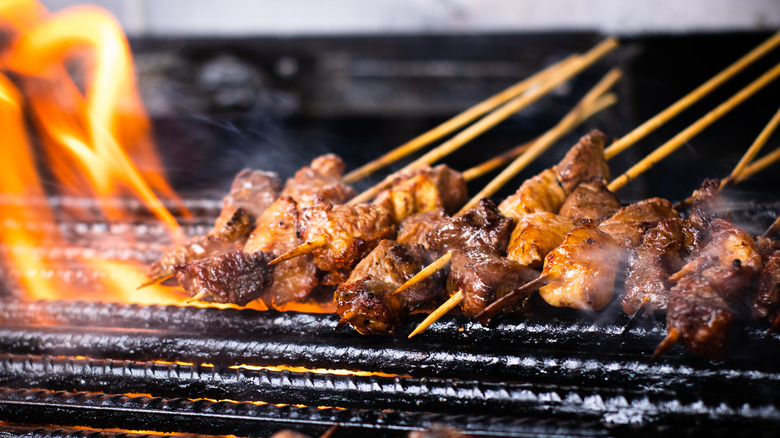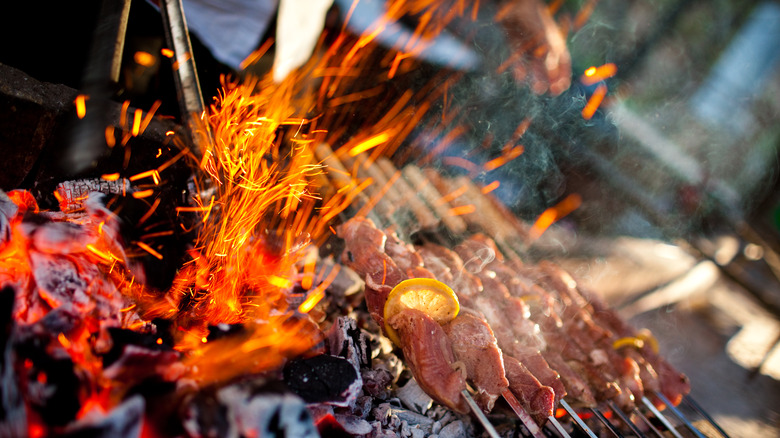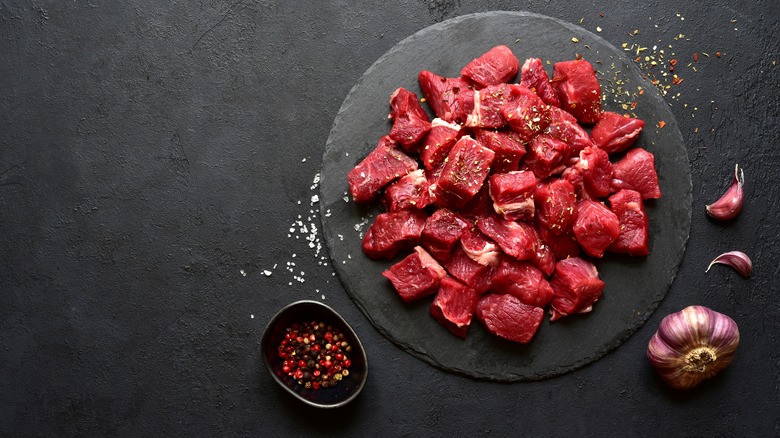BBQ Fans Need To Try Africa's Mshakiki Steak Kabobs
Skewered meats come in all shapes and sizes around the world, unified by one quality — they're dependably delicious. A thoughtful marinade combined with a charcoal grill will make many cuts of meat shine. No surprise the cooking method is employed across many cultures, especially in the Islamic world.
A Comorian riff on grilled skewered meats is called mshakiki. While the recipe originated in the Comoros, it has spread across East Africa. It consists of beef chunks covered in a complex spice mix influenced by trade routes to India. An acidic element tenderizes the meat during a lengthy marination. Grilled over charcoal, the spices develop a delectable smoky aroma which imbues the kabobs with added flavor.
A popular street food or part of a larger meal, mshakiki's appeal is evident at first sight. Whether served with a salad or on their own, the skewers are a mouth-watering delight. Let's dive into the dish's global array of influences and how it's prepared.
The multicultural history of mshakiki kabobs
Mshakiki kabobs are consumed across Eastern Africa, but they're especially intertwined with Swahili cuisine. As a predominantly Muslim culture, Swahili cuisine shares attributes with other Islamic cooking traditions. So no surprise mshakiki resemble kabob skewers enjoyed in Middle Eastern countries like Yemen and Northern Africa.
The aromatics utilized in mshakiki kabobs hail from diverse origins, showcasing Swahili's prominence in trade routes. Cumin and dried chiles comprise a frequent base, compounded by an extensive selection of other spices like turmeric, allspice, thyme, and coriander. Asian-style aromatics like ginger and garlic also make an appearance. Components frequently shift, with varying spice combinations and heat levels.
Today, mshakiki kabobs are enjoyed both as an affordable street food and inside the home. They're especially popular in Kenya and Tanzania, where they're served alongside other dishes like biryani, fries, and salad. Let's dive into how the tasty grilled skewers come together.
How mishkaki kabobs are made
As a skewered-meat dish, the preparation of mshakiki kabobs starts by sourcing beef. Typically, the recipe employs a leaner cut like rump steak or sirloin – although the exact meat selection varies.
Next, the beef is cubed and mixed into a marinade. The seasoning builds upon an acidic component like vinegar, citrus juice, or tamarind paste. Spice additions vary; cumin, ginger, garlic, and chile are the most common cornerstones. Other flavors include turmeric, grated papaya (which contains an enzyme that tenderizes meat), or other fruit. As evidenced by the variation between recipes, mshakiki kabobs encompass a malleable range of tastes.
Once mixed together, the meat chunks are marinated for an extended duration, up to overnight. They're then skewered, with some cooks also adding peppers and onions. The kabobs are prepared over a charcoal grill, slowly turned, and basted with oil. Once ready, they're served standalone on a platter or garnished with a fresh salad. The meat's complex seasoning speaks for itself; the delicious skewers will dependably steal all the attention during a grilled meal.


